
Pipistrellus is a genus of bats in the family Vespertilionidae and subfamily Vespertilioninae. The name of the genus is derived from the Italian word pipistrello, meaning "bat".

The tricolored bat is a species of microbat native to eastern North America. Formerly known as the eastern pipistrelle, based on the errant belief that it was closely related to European Pipistrellus species, the closest known relative of the tricolored bat is now recognized as the canyon bat. Its common name "tricolored bat" derives from the coloration of the hairs on its back, which have three distinct color bands. It is the smallest bat species in the eastern and midwestern US, with individuals weighing only 4.6–7.9 g (0.16–0.28 oz). This species mates in the fall before hibernation, though due to sperm storage, females do not become pregnant until the spring. Young are born helpless, though rapidly develop, flying and foraging for themselves by four weeks old. It has a relatively long lifespan, and can live nearly fifteen years.

Usnea is a genus of mostly pale grayish-green fruticose lichens that grow like leafless mini-shrubs or tassels anchored on bark or twigs. The genus is in the family Parmeliaceae. It grows all over the world. Members of the genus are commonly called old man's beard, beard lichen, or beard moss.

The little red flying-fox is a megachiropteran bat native to northern and eastern Australia. The species weighs about half a kilogram, one US pound, and is the smallest species of Pteropus in mainland Australia. P. scapulatus occurs at the coast and further inland, camping and flying to the tropical to temperate regions that provide them with an annual source of nectar. They exhibit an unusual method of obtaining drinking water during dry periods, skimming a stream's surface to gather it onto their fur while they are in flight.
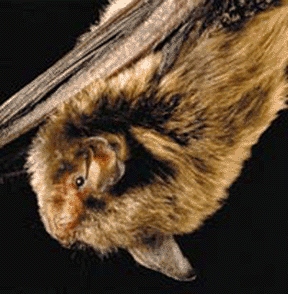
The Indiana bat is a medium-sized mouse-eared bat native to North America. It lives primarily in Southern and Midwestern U.S. states and is listed as an endangered species. The Indiana bat is grey, black, or chestnut in color and is 1.2–2.0 in long and weighs 4.5–9.5 g (0.16–0.34 oz). It is similar in appearance to the more common little brown bat, but is distinguished by its feet size, toe hair length, pink lips, and a keel on the calcar.

Spix’s disk-winged bat, is a species of bat in the family Thyropteridae. It is native to the Americas from Mexico to Brazil. The most prominent anatomical feature of this bat, which distinguishes it from other species, is the disks on its thumbs and hind feet. These circular disks act as suction cups, allowing the bats to cling onto and move along smooth surfaces.

The Bonda mastiff bat or Thomas's mastiff bat, is a species of mastiff bat from South and Central America. It is named for the town of Bonda, near Santa Marta in Colombia.

Erioderma pedicellatum is a medium-sized, foliose lichen in the family Pannariaceae, commonly called the boreal felt lichen. It grows on trees in damp boreal forests along the Atlantic coast in Canada, as well as in southcentral Alaska and in the Kamchatka Peninsula.

Hodgson's bat, also called the copper-winged bat or black-and-orange myotis, is a species of vesper bat in the genus Myotis, the mouse-eared bats. Favouring mountain forests, it is found throughout Central, Southeast, and East Asia, from Afghanistan to Taiwan. It is about 5 centimetres (2.0 in) long and is distinguished from most other species of bat in this range by its yellowish colouration.
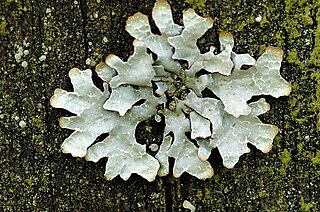
Parmelia sulcata is a foliose lichen in the family Parmeliaceae. It is very tolerant of pollution and has a cosmopolitan distribution, making it one of the most common lichens. It harbours a unicellular Trebouxia green algal symbiont.
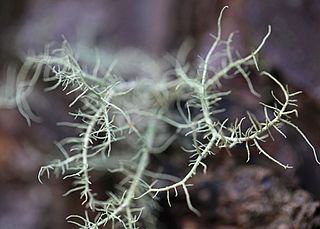
Usnea longissima, known by the name old man's beard or Methuselah's beard lichen, is a lichen in the family Parmeliaceae.
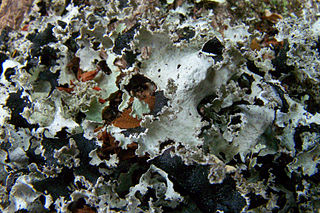
Platismatia is genus of medium to large foliose lichens with rather crinkled lobes. The genus is widespread and contains 10 species. They resemble many other genera of foliose lichens in the family Parmeliaceae, particularly Parmotrema, Cetrelia, and Asahinea. Most species are found in forests on the trunks and branches of conifer trees, although some species grow on rocks.

The cinnamon red bat is a species of bat in the family Vespertilionidae. It was first described from a specimen that had been collected in Chile. For more than one hundred years after its initial description, it was largely considered a synonym of the eastern red bat. From the 1980s onward, it was frequently recognized as distinct from the eastern red bat due to its fur coloration and differences in range. It has deep red fur, lacking white "frosting" on the tips of individual hairs seen in other members of Lasiurus. It has a forearm length of 39–42 mm (1.5–1.7 in) and a weight of 9.5–11.0 g (0.34–0.39 oz).
There are eighteen indigenous species of bats in Canada, which are found in many parts of the country. They are insectivores, and are prey to falcons, hawks, owls, snakes, cats, and raccoons.

Usnea filipendula, the fishbone beard lichen, is a pale gray-green fruticose lichen with a pendant growth form, growing in up to 20 cm many-branching tassels hanging from the bark of trees. In California, it mostly grows on mostly conifer in the Coast Range, but also in the western slopes of the Sierra Nevada range. It lacks apothecia. It is similar to Usnea scabrata, but is darker, has a thicker cortex, and different chemistry. Lichen spot tests are K+ red, KC−, C−, and P+ yellow.
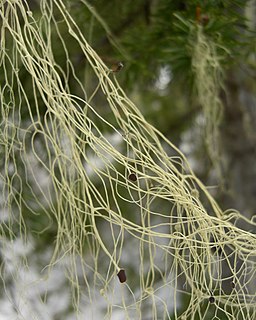
Alectoria sarmentosa is a long-lived, perennial witch's-hair lichen. It is also sometimes classified as a fungus. It is a light greenish colored and fruticose or bushy bodied. This epiphytic lichen belongs to the family Parmeliaceae and the suborder Lecanorineae, which includes six similar species. A. sarmentosa grows draped or strung over conifer tree limbs and deciduous shrub branches in Northern temperate rainforest. This lichen favors mature and old growth, wet conifer and hardwood forests with clean air. A. sarmentosa is sensitive to air pollution and used for air quality monitoring. Areas required by A. sarmentosa are found in northern and southern temperate zones and receive high rainfall. This lichen is commonly found in transitional areas between valley and mountainous forests, but usually avoiding the immediate coast.

Usnea mutabilis is a grayish-yellowish pale green, unequally branching, shrubby (fruticose) 3–7 cm long lichen commonly anchored on holdfasts on trees, mostly in eastern North America, sometimes in chaparral shrubs or pines in California. It is darker green than other members of the genus Usnea. The surface is covered with isolated, or clusters of, isidia. It lacks apothecia.

Punctelia appalachensis, commonly known as the Appalachian speckled shield lichen, is a species of foliose lichen in the family Parmeliaceae. It is found in the eastern United States and eastern Canada. The lichen was first formally described in 1962 by lichenologist William Culberson as a species of Parmelia. He collected the type specimen growing on tree bark in West Virginia, Hildur Krog transferred it to the newly circumscribed genus Punctelia in 1982.

Perimyotini is a tribe of bats in the family Vespertilionidae. It contains two species of bats found in North America, each in their own monotypic genus.

Gowardia nigricans, commonly known as the gray hair lichen or gray witch's hair, is a species of fruticose lichen in the family Parmeliaceae.



















